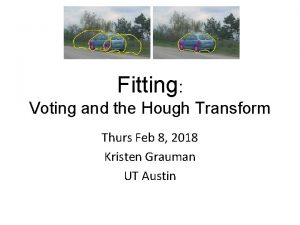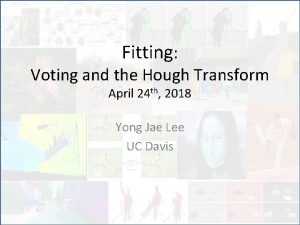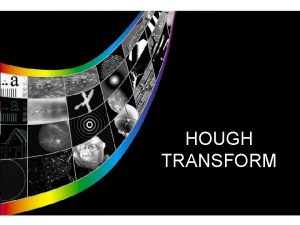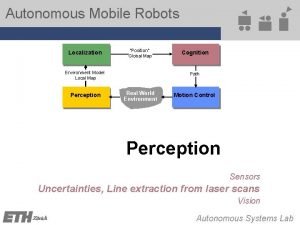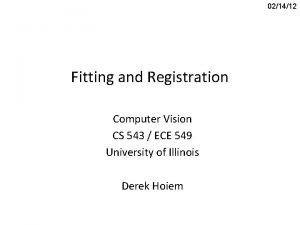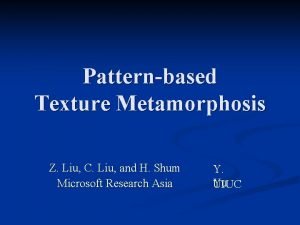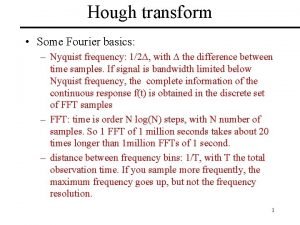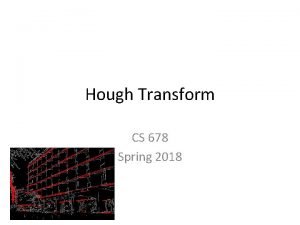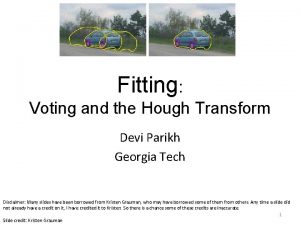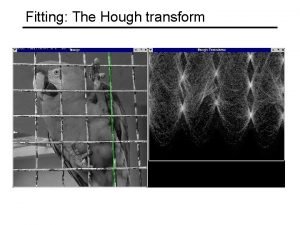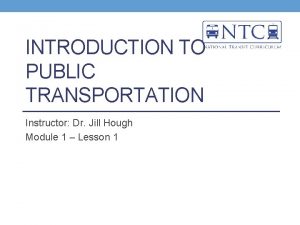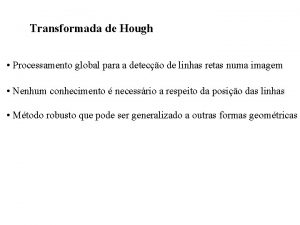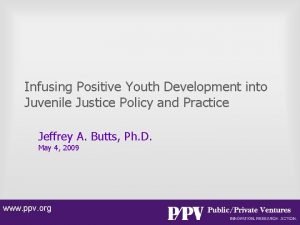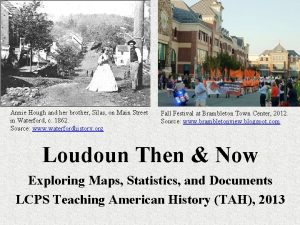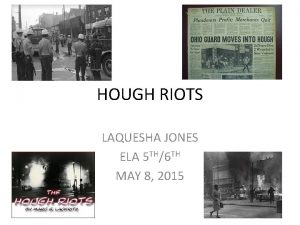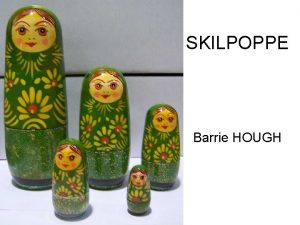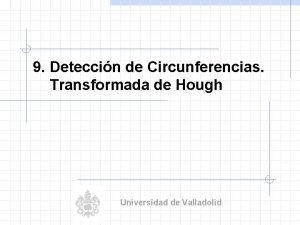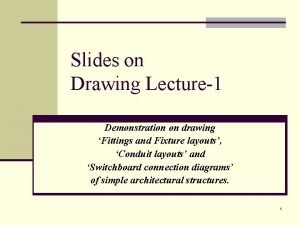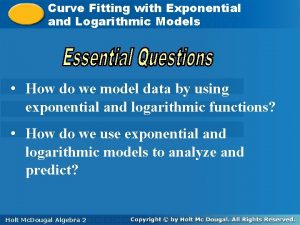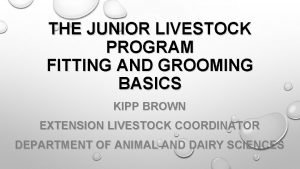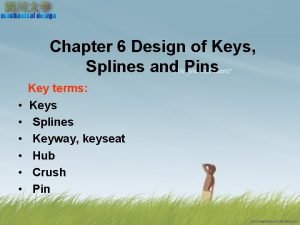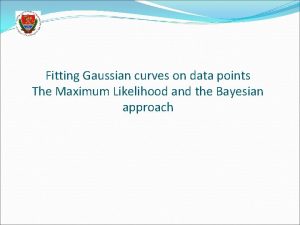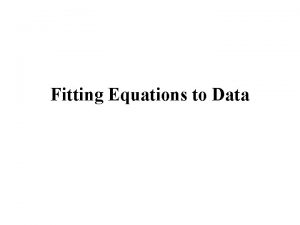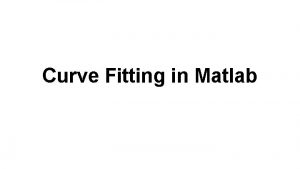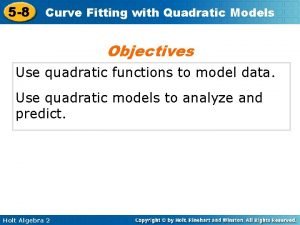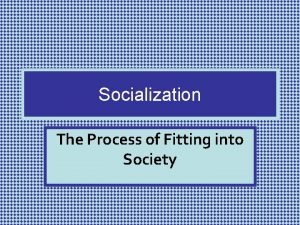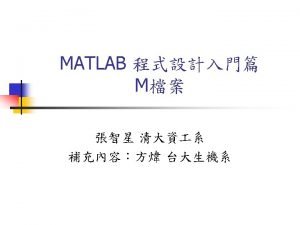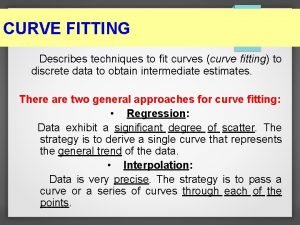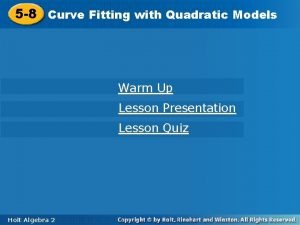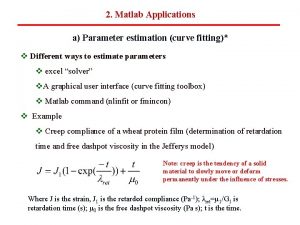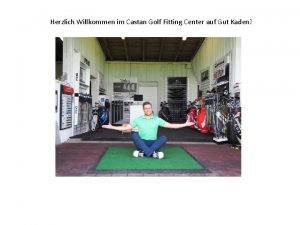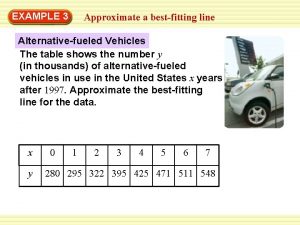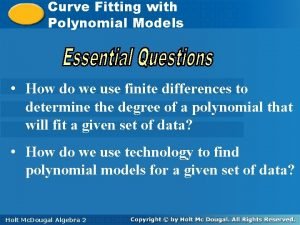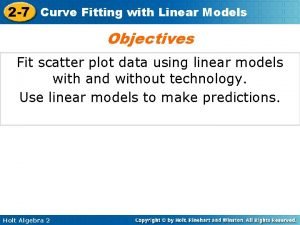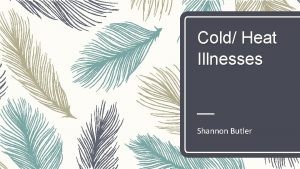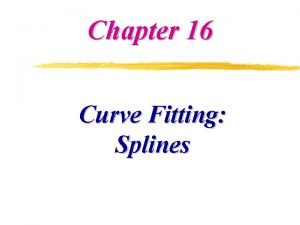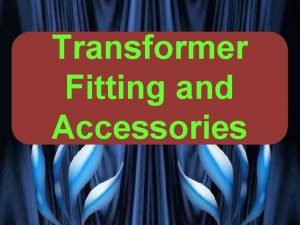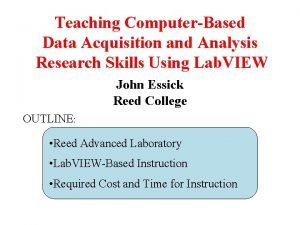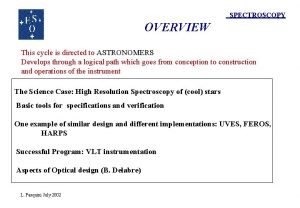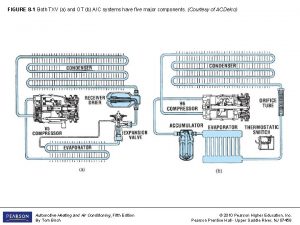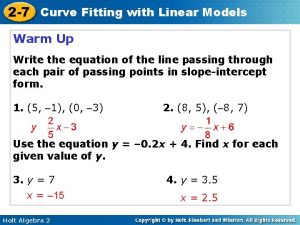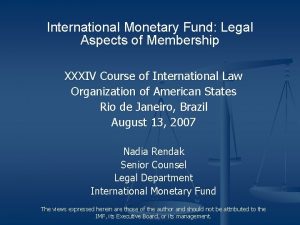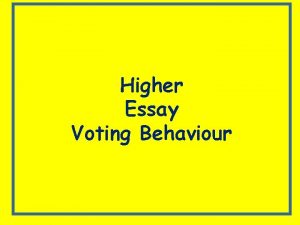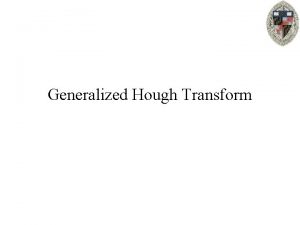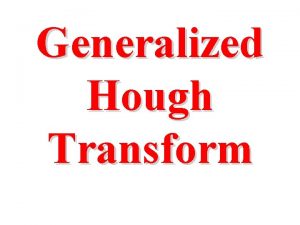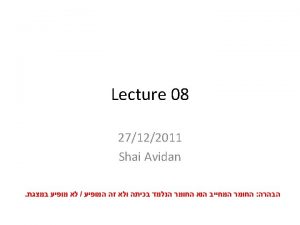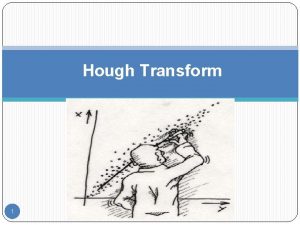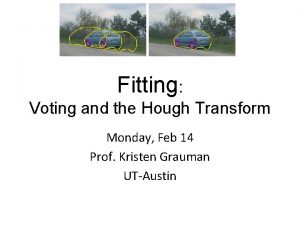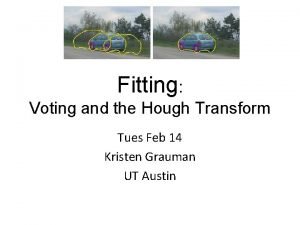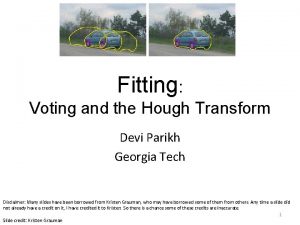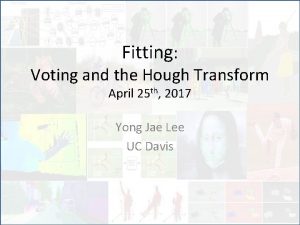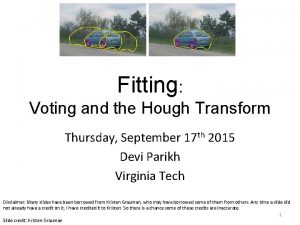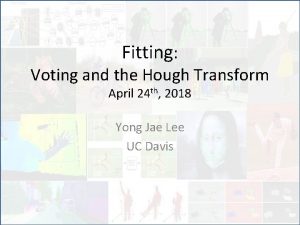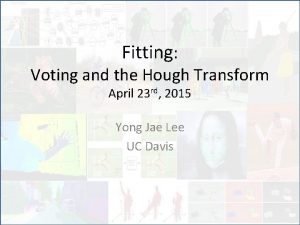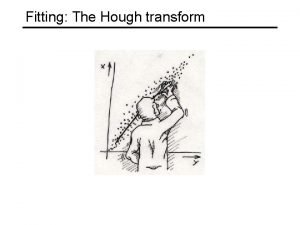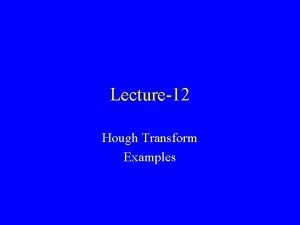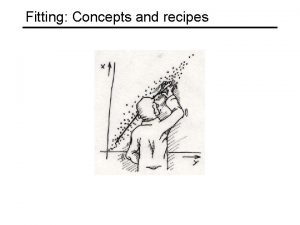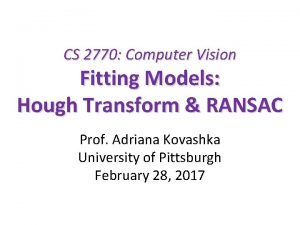Fitting Voting and the Hough Transform part 2
















































- Slides: 48

Fitting: Voting and the Hough Transform (part 2) Kristen Grauman UT Austin Feb 16, 2017

Announcements • A 2 due next Friday • Anonymous course survey – see link on Piazza – Please respond by next Thursday 2/23

Review: graph-based clustering • Assuming we use a fully connected graph, what is the time complexity of computing the affinities for a graph cuts-based segmentation? • Example affinity measure: X(i) is position of node i F(i) is a feature vector for node i based on color, texture, etc. This affinity measure limits connections to spatially close pixels. Slide credit: Kristen Grauman

Now: Fitting • Want to associate a model with observed features [Fig from Marszalek & Schmid, 2007] For example, the model could be a line, a circle, or an arbitrary shape. Slide credit: Kristen Grauman

Recall: Voting • It’s not feasible to check all combinations of features by fitting a model to each possible subset. • Voting is a general technique where we let the features vote for all models that are compatible with it. – Cycle through features, cast votes for model parameters. – Look for model parameters that receive a lot of votes. • Noise & clutter features will cast votes too, but typically their votes should be inconsistent with the majority of “good” features.

Recall: Fitting lines: Hough transform • Given points that belong to a line, what is the line? • How many lines are there? • Which points belong to which lines? • Hough Transform is a voting technique that can be used to answer all of these questions. Main idea: 1. Record vote for each possible line on which each edge point lies. 2. Look for lines that get many votes. Slide credit: Kristen Grauman

Finding lines in an image: Hough space y b b 0 x image space m 0 m Hough (parameter) space Connection between image (x, y) and Hough (m, b) spaces • A line in the image corresponds to a point in Hough space • To go from image space to Hough space: – given a set of points (x, y), find all (m, b) such that y = mx + b Slide credit: Steve Seitz

Finding lines in an image: Hough space y b y 0 x image space m Hough (parameter) space Connection between image (x, y) and Hough (m, b) spaces • A line in the image corresponds to a point in Hough space • To go from image space to Hough space: – given a set of points (x, y), find all (m, b) such that y = mx + b • What does a point (x 0, y 0) in the image space map to? – Answer: the solutions of b = -x 0 m + y 0 – this is a line in Hough space Slide credit: Steve Seitz

Finding lines in an image: Hough space y y 0 b (x 1, y 1) (x 0, y 0) b = –x 1 m + y 1 x 0 x image space m Hough (parameter) space What are the line parameters for the line that contains both (x 0, y 0) and (x 1, y 1)? • It is the intersection of the lines b = –x 0 m + y 0 and b = –x 1 m + y 1

Finding lines in an image: Hough algorithm y b x image space m Hough (parameter) space How can we use this to find the most likely parameters (m, b) for the most prominent line in the image space? • Let each edge point in image space vote for a set of possible parameters in Hough space • Accumulate votes in discrete set of bins; parameters with the most votes indicate line in image space.

Polar representation for lines Issues with usual (m, b) parameter space: can take on infinite values, undefined for vertical lines. Image columns Image rows [0, 0] : perpendicular distance from line to origin : angle the perpendicular makes with the x-axis Written in image coordinates Point in image space sinusoid segment in Hough space Slide credit: Kristen Grauman

Hough transform algorithm Using the polar parameterization: Basic Hough transform algorithm H: accumulator array (votes) d 1. Initialize H[d, ]=0 2. for each edge point I[x, y] in the image for = [ min to max ] // some quantization H[d, ] += 1 3. Find the value(s) of (d, ) where H[d, ] is maximum 4. The detected line in the image is given by Time complexity (in terms of number of votes per pt)? Source: Steve Seitz

• https: //www. youtube. com/watch? v=ebfi 7 q. OFLuo

Example: What’s in the image? Square : Circle :

Example: Hough transform for straight lines Which line do you think generated the brightest peak?

Original image Canny edges Vote space and top peaks Slide credit: Kristen Grauman

Showing longest segments found Slide credit: Kristen Grauman

Impact of noise on Hough d y x Image space edge coordinates Votes What difficulty does this present for an implementation?

Impact of noise on Hough Image space edge coordinates Votes Here, everything appears to be “noise”, or random edge points, but we still see peaks in the vote space.

From before: Hough transform algorithm Using the polar parameterization: Basic Hough transform algorithm H: accumulator array (votes) d 1. Initialize H[d, ]=0 2. for each edge point I[x, y] in the image for = [ min to max ] // some quantization H[d, ] += 1 3. Find the value(s) of (d, ) where H[d, ] is maximum 4. The detected line in the image is given by Source: Steve Seitz

Extensions Extension 1: Use the image gradient 1. same 2. for each edge point I[x, y] in the image = gradient at (x, y) H[d, ] += 1 3. same 4. same (Reduces degrees of freedom) Extension 2 • give more votes for stronger edges Extension 3 • change the sampling of (d, ) to give more/less resolution Extension 4 • The same procedure can be used with circles, squares, or any other shape

Extensions Extension 1: Use the image gradient 1. same 2. for each edge point I[x, y] in the image compute unique (d, ) based on image gradient at (x, y) H[d, ] += 1 3. same 4. same (Reduces degrees of freedom) Extension 2 • give more votes for stronger edges (use magnitude of gradient) Extension 3 • change the sampling of (d, ) to give more/less resolution Extension 4 • The same procedure can be used with circles, squares, or any other shape… Source: Steve Seitz

Hough transform for circles • Circle: center (a, b) and radius r • For a fixed radius r, unknown gradient direction Hough space Image space Slide credit: Kristen Grauman

Hough transform for circles • Circle: center (a, b) and radius r • For a fixed radius r, unknown gradient direction Intersection: most votes for center occur here. Hough space Image space Slide credit: Kristen Grauman

Hough transform for circles • Circle: center (a, b) and radius r • For an unknown radius r, unknown gradient direction r ? b a Image space Slide credit: Kristen Grauman Hough space

Hough transform for circles • Circle: center (a, b) and radius r • For an unknown radius r, unknown gradient direction r b a Image space Slide credit: Kristen Grauman Hough space

Hough transform for circles • Circle: center (a, b) and radius r • For an unknown radius r, known gradient direction x θ Hough space Image space Slide credit: Kristen Grauman

Hough transform for circles For every edge pixel (x, y) : For each possible radius value r: For each possible gradient direction θ: // or use estimated gradient at (x, y) a = x + r cos(θ) // column b = y - r sin(θ) // row H[a, b, r] += 1 end Time complexity per edgel? • Check out online demo : http: //www. markschulze. net/java/hough/

Example: detecting circles with Hough Original Edges Votes: Penny Note: a different Hough transform (with separate accumulators) wa used for each circle radius (quarters vs. penny).

Example: detecting circles with Hough Original Combined detections Edges Votes: Quarter Coin finding sample images from: Vivek Kwatra

Example: iris detection Gradient+threshold • Hough space (fixed radius) Hemerson Pistori and Eduardo Rocha Costa http: //rsbweb. nih. gov/ij/plugins/hough-circles. html Max detections

Example: iris detection • An Iris Detection Method Using the Hough Transform and Its Evaluation for Facial and Eye Movement, by Hideki Kashima, Hitoshi Hongo, Kunihito Kato, Kazuhiko Yamamoto, ACCV 2002.

Voting: practical tips • Minimize irrelevant tokens first • Choose a good grid / discretization Too fine ? Too coarse • Vote for neighbors, also (smoothing in accumulator array) • Use direction of edge to reduce parameters by 1 • To read back which points voted for “winning” peaks, keep tags on the votes. Slide credit: Kristen Grauman

Hough transform: pros and cons Pros • All points are processed independently, so can cope with occlusion, gaps • Some robustness to noise: noise points unlikely to contribute consistently to any single bin • Can detect multiple instances of a model in a single pass Cons • Complexity of search time increases exponentially with the number of model parameters • Non-target shapes can produce spurious peaks in parameter space • Quantization: can be tricky to pick a good grid size Slide credit: Kristen Grauman

Generalized Hough Transform • What if we want to detect arbitrary shapes? Intuition: Displacement vectors x xx Ref. point Model image x Novel image x Vote space Now suppose those colors encode gradient directions… Slide credit: Kristen Grauman

Generalized Hough Transform • Define a model shape by its boundary points and a reference point. Offline procedure: x θ a θ p 2 p 1 Model shape … θ θ … At each boundary point, compute displacement vector: r = a – pi. Store these vectors in a table indexed by gradient orientation θ. … [Dana H. Ballard, Generalizing the Hough Transform to Detect Arbitrary Shapes, 1980] Slide credit: Kristen Grauman

Generalized Hough Transform Detection procedure: x For each edge point: • Use its gradient orientation θ to index into stored table • Use retrieved r vectors to vote for reference point xx θ θ p 1 θ Novel image … θ θ … … Assuming translation is the only transformation here, i. e. , orientation and scale are fixed. Slide credit: Kristen Grauman θ

Generalized Hough for object detection • Instead of indexing displacements by gradient orientation, index by matched local patterns. “visual codeword” with displacement vectors training image B. Leibe, A. Leonardis, and B. Schiele, Combined Object Categorization and Segmentation with an Implicit Shape Model, ECCV Workshop on Statistical Learning in Computer Vision 2004 Source: L. Lazebnik

Generalized Hough for object detection • Instead of indexing displacements by gradient orientation, index by “visual codeword” test image B. Leibe, A. Leonardis, and B. Schiele, Combined Object Categorization and Segmentation with an Implicit Shape Model, ECCV Workshop on Statistical Learning in Computer Vision 2004 Source: L. Lazebnik

Perceptual and. Recognition Sensory Augmented Visual Object Tutorial Computing Example: Results on Cows Original image K. Grauman, B. Leibe

Perceptual and. Recognition Sensory Augmented Visual Object Tutorial Computing Example: Results on Cows Interest Originalpoints image K. Grauman, B. Leibe

Perceptual and. Recognition Sensory Augmented Visual Object Tutorial Computing Example: Results on Cows Interest Originalpoints image Matched patches K. Grauman, B. Leibe

Perceptual and. Recognition Sensory Augmented Visual Object Tutorial Computing Example: Results on Cows Interest Original points image Matched patches Votes K. Grauman, B. Leibe 43

Perceptual and. Recognition Sensory Augmented Visual Object Tutorial Computing Example: Results on Cows 1 st hypothesis K. Grauman, B. Leibe 44

Perceptual and. Recognition Sensory Augmented Visual Object Tutorial Computing Example: Results on Cows 2 nd hypothesis K. Grauman, B. Leibe 45

Perceptual and. Recognition Sensory Augmented Visual Object Tutorial Computing Example: Results on Cows 3 rd hypothesis K. Grauman, B. Leibe 46

Summary • Grouping/segmentation useful to make a compact representation and merge similar features – associate features based on defined similarity measure and clustering objective • Fitting problems require finding any supporting evidence for a model, even within clutter and missing features. – associate features with an explicit model • Voting approaches, such as the Hough transform, make it possible to find likely model parameters without searching all combinations of features. – Hough transform approach for lines, circles, …, arbitrary shapes defined by a set of boundary points, recognition from patches. Slide credit: Kristen Grauman

Coming up Fitting with deformable contours
 Hough voting
Hough voting Hough voting
Hough voting Hough transform
Hough transform Hough transform
Hough transform Hough transform
Hough transform Generalized hough transform
Generalized hough transform Hough transform
Hough transform Hough
Hough Hough transform
Hough transform Hough transform
Hough transform Jill hough
Jill hough Transformada de hough
Transformada de hough Bruce robert hough
Bruce robert hough Annie hough
Annie hough Emily hough nhs
Emily hough nhs Cleveland hough riots
Cleveland hough riots Skilpoppe barrie hough
Skilpoppe barrie hough Transformada hough
Transformada hough Hough raum
Hough raum Conduit layout diagram
Conduit layout diagram Exponential and logarithmic models
Exponential and logarithmic models Steer clipping and fitting techniques
Steer clipping and fitting techniques Fitting keys and splines
Fitting keys and splines Pros and cons of fptp
Pros and cons of fptp Pilkington spider fitting
Pilkington spider fitting Gaussian curve fitting
Gaussian curve fitting Fitting equations to data
Fitting equations to data Curve fitting matlab
Curve fitting matlab Quadratic curve fitting
Quadratic curve fitting Fitting into society
Fitting into society Matlab
Matlab Curve fitting techniques
Curve fitting techniques Curve fitting with quadratic models
Curve fitting with quadratic models Parameter estimation matlab
Parameter estimation matlab Castan golf
Castan golf Approximate the best fitting line for the data
Approximate the best fitting line for the data Curve fitting with polynomial models
Curve fitting with polynomial models Curve fitting with linear models
Curve fitting with linear models Dr comfort return form
Dr comfort return form Loose-fitting clothing
Loose-fitting clothing Quadratic spline interpolation example
Quadratic spline interpolation example Transformer fittings and accessories
Transformer fittings and accessories Labview curve fitting
Labview curve fitting Hyades
Hyades A/c fitting size chart
A/c fitting size chart Curve fitting with linear models
Curve fitting with linear models Imf functions
Imf functions Voting behaviour essay
Voting behaviour essay Voting rights
Voting rights
